Effect of Nano-Sized γ′ Phase on the Ultrasonic and Mechanical Properties of Ni-Based Superalloy
Abstract
:1. Introduction
2. Experimental Procedures
3. Results and Discussion
3.1. Microstructural Evolution
3.2. Ultrasonic Properties
3.3. Mechanical Properties
4. Conclusions
Author Contributions
Funding
Data Availability Statement
Conflicts of Interest
References
- Shaikh, A.S.; Rashidi, M.; Minet-Lallemand, K.; Hryha, E. On as-built microstructure and necessity of solution treatment in additively manufactured Inconel 939. Powder Metall. 2022, 2, 1–9. [Google Scholar] [CrossRef]
- Sadeghian, A.; Arhami, F.; Mirsalehi, S.E. Phase formation during dissimilar transient liquid phase (TLP) bonding of IN939 to IN625 using a Ni-Cr-Fe-Si-B interlayer. J. Manuf. Process. 2019, 44, 72–80. [Google Scholar] [CrossRef]
- Shin, K.Y.; Kim, J.H.; Terner, M.; Kong, B.O.; Hong, H.U. Effects of heat treatment on the microstructure evolution and the high-temperature tensile properties of Haynes 282 superalloy. Mater. Sci. Eng. A 2019, 751, 311–322. [Google Scholar] [CrossRef]
- Sun, Z.Y.; Ren, S.; Hu, T.M.; Li, B. Effect of ultrasonic surface rolling process on the hot compression behavior of Inconel 718 superalloy at 700 °C. Nanomaterials 2019, 9, 658. [Google Scholar] [CrossRef] [Green Version]
- Gai, Y.C.; Zhang, R.; Yang, J.X.; Cui, C.Y.; Qu, J.L. Effects of heat treatment on γ′ precipitates and tensile properties of a Ni-base superalloy. Mater. Sci. Eng. A 2022, 842, 143079. [Google Scholar] [CrossRef]
- Kim, D.; Jiang, R.; Evangelou, A.; Sinclair, I.; Reed, P.A.S. Effects of γ′ size and carbide distribution on fatigue crack growth mechanisms at 650 ° C in an advanced Ni-based superalloy. Int. J. Fatigue 2021, 145, 106086. [Google Scholar] [CrossRef]
- Zhu, L.H.; Pan, H.; Cheng, J.Y.; Xiao, L.; Guo, J.Z.; Ji, H.J. Dendrite evolution and quantitative characterization of γ′ precipitates in a powder metallurgy Ni-based superalloy by different cooling rates. J. Alloys Compd. 2022, 918, 165677. [Google Scholar] [CrossRef]
- Mallikarjuna, H.T.; Caley, W.F.; Richards, N.L. The effect of cooling rate on the γ′ composition, morphology and corrosion behaviour of IN738LC. Corros. Sci. 2019, 149, 37–44. [Google Scholar] [CrossRef]
- Wu, H.Y.; Zhuang, X.L.; Nie, Y.; Li, Y.P.; Jiang, L. Effect of heat treatment on mechanical property and microstructure of a powder metallurgy nickel-based superalloy. Mater. Sci. Eng. A 2019, 754, 29–37. [Google Scholar] [CrossRef]
- Kim, I.S.; Choi, B.G.; Jung, J.E.; Do, J.; Seok, W.Y.; Lee, Y.H.; Jeong, I.Y. Effect of heat treatment on microstructural evolution and creep behaviors of a conventionally cast nickel-based superalloy. Mater. Charact. 2020, 165, 110378. [Google Scholar] [CrossRef]
- Silva, C.C.; De Albuquerque, V.H.C.; Miná, E.M.; Moura, E.P.; Tavares, J.M.R.S. Mechanical properties and microstructural characterization of aged nickel-based alloy 625 weld metal. Metall. Mater. Trans. A 2018, 49, 1653–1673. [Google Scholar] [CrossRef] [Green Version]
- Toozandehjani, M.; Matori, K.A.; Ostovan, F.; Mustapha, F.; Zahari, N.I.; Oskoueianet, A. On the correlation between microstructural evolution and ultrasonic properties: A review. J. Mater. Sci. 2015, 50, 2643–2665. [Google Scholar] [CrossRef]
- Behjati, P.; Dastjerdi, H.V.; Mahdavi, R. Influence of ageing process on sound velocity in C17200 copper-beryllium alloy. J. Alloys Compd. 2010, 505, 739–742. [Google Scholar] [CrossRef]
- Murthy, G.V.S.; Sridhar, G.; Kumar, A.; Jayakumar, T. Characterization of intermetallic precipitates in a Nimonic alloy by ultrasonic velocity measurements. Mater. Charact. 2009, 60, 234–239. [Google Scholar] [CrossRef]
- Jahangiri, M. Different effects of γ′ and η phases on the physical and mechanical properties of superalloys. J. Alloys Compd. 2019, 802, 535–545. [Google Scholar] [CrossRef]
- Palanichamy, P.; Mathew, M.D.; Latha, S.; Jayakumar, T.; Rao, K.B.S.; Mannan, S.L.; Raj, B. Assessing microstructural changes in alloy 625 using ultrasonic waves and correlation with tensile properties. Scr. Mater. 2001, 45, 1025–1030. [Google Scholar] [CrossRef]
- Wang, J.J.; Wen, Z.X.; Pei, H.Q.; Gu, S.N.; Zhang, C.J.; Yue, Z.F. Thermal damage evaluation of nickel-based superalloys based on ultrasonic nondestructive testing. Appl. Acoust. 2021, 183, 108329. [Google Scholar] [CrossRef]
- Chen, X.; Wu, G.H.; Chen, H.; Zhou, Z.G. A multi-parameter ultrasonic evaluation of mean grain size using optimization. NDT E Int. 2019, 106, 10–17. [Google Scholar] [CrossRef]
- Zhang, W.; Chen, X.; Li, M.; Chen, H.; Wu, G.H.; Zhang, C.X. Application of high-dimensional model representation in the ultrasonic evaluation of superalloy grain size. J. Nondestruct. Eval. 2022, 41, 57. [Google Scholar] [CrossRef]
- Murthy, G.V.S.; Ghosh, S.; Das, M.; Das, G.; Ghosh, R.N. Correlation between ultrasonic velocity and indentation-based mechanical properties with microstructure in Nimonic 263. Mater. Sci. Eng. A 2008, 488, 398–405. [Google Scholar] [CrossRef]
- Mukhopadhyay, A.; Chatterjee, D.; Mondal, C.; Punnose, S.; Gopinath, K. Characterization of microstructural changes due to prolonged thermal exposure of directionally solidified Ni-base super alloy CM 247LC using ultrasonic. Ultrasonics 2018, 90, 42–51. [Google Scholar] [CrossRef] [PubMed]
- Sindhura, D.; Sravya, M.V.; Murthy, G.V.S. Comprehensive microstructural evaluation of precipitation in Inconel 718. Metallogr. Microstruct. Anal. 2019, 8, 233–240. [Google Scholar] [CrossRef]
- Aghaie-Khafri, M.; Honarvar, F.; Zangeneh, S. Correlation between ultrasonic velocity and solutionising time in Rene 80 superalloy. Mater. Sci. Technol. 2011, 27, 1433–1435. [Google Scholar] [CrossRef]
- Kumar, A.; Shankar, V.; Jayakumar, T.; Bhanu Sankara Rao, K.; Raj, B. Correlation of microstructure and mechanical properties with ultrasonic velocity in the Ni-based superalloy Inconel 625. Philos. Mag. A 2002, 82, 2529–2545. [Google Scholar] [CrossRef]
- Chen, X.; Wu, G.H.; Zhou, Z.G.; Tai, Q.G. Study of the relationship between ultrasonic properties and microstructure of nickel-based superalloy GH706. Insight Non-Destr. Test. Cond. Monit. 2017, 59, 609–614. [Google Scholar] [CrossRef]
- Albuqueque, V.H.C.; Silva, C.C.; Normando, P.G.; Moura, E.P.; Tavares, J.M.R.S. Thermal aging effects on the microstructure of Nb-bearing nickel based superalloy weld overlays using ultrasound techniques. Mater. Des. 2012, 36, 337–347. [Google Scholar] [CrossRef]
- Pathak, S.; Verma, R.; Kumar, P.; Singh, A.; Singhal, S.; Sharama, P.; Jain, K.; Pant, R.P.; Wang, X. Facile synthesis, static, and dynamic magnetic characteristics of varying size double-surfactant-coated mesoscopic magnetic nanoparticles dispersed stable aqueous magnetic fluids. Nanomaterials 2021, 11, 3009. [Google Scholar] [CrossRef]
- Nitas, M.; Salonikios, V.; Antonopoulos, C.S.; Yioultsis, T.V. Numerical calculation of dispersion diagrams and field distributions of waves in 3-D periodic split-ring resonator media. IEEE Trans. Magn. 2019, 55, 1–4. [Google Scholar] [CrossRef]
- Pathak, S.; Verma, R.; Singhal, S.; Chaturvedi, R.; Kumar, P.; Sharma, P.; Pant, R.P.; Wang, X. Spin dynamics investigations of multifunctional ambient scalable Fe3O4 surface decorated ZnO magnetic nanocomposite using FMR. Sci. Rep. 2021, 11, 3799. [Google Scholar] [CrossRef]
- Wu, R.H.; Sandfeld, S. Insights from a minimal model of dislocation-assisted rafting in single crystal Nickel-based superalloys. Scr. Mater. 2016, 123, 42–45. [Google Scholar] [CrossRef]
- Barjesteh, M.M.; Abbasi, S.M.; Madar, K.Z.; Shirvani, K. The effect of heat treatment on characteristics of the gamma prime phase and hardness of the nickel-based superalloy Rene® 80. Mater. Chem. Phys. 2019, 227, 46–55. [Google Scholar] [CrossRef]
- Chen, Q.; Huang, Z.; Zhao, Z.; Hu, C. First-principles study on the structural, elastic, and thermodynamics properties of Ni3X (X: Al, Mo, Ti, Pt, Si, Nb, V, and Zr) intermetallic compounds. Appl. Phys. A 2014, 116, 1161–1172. [Google Scholar] [CrossRef]
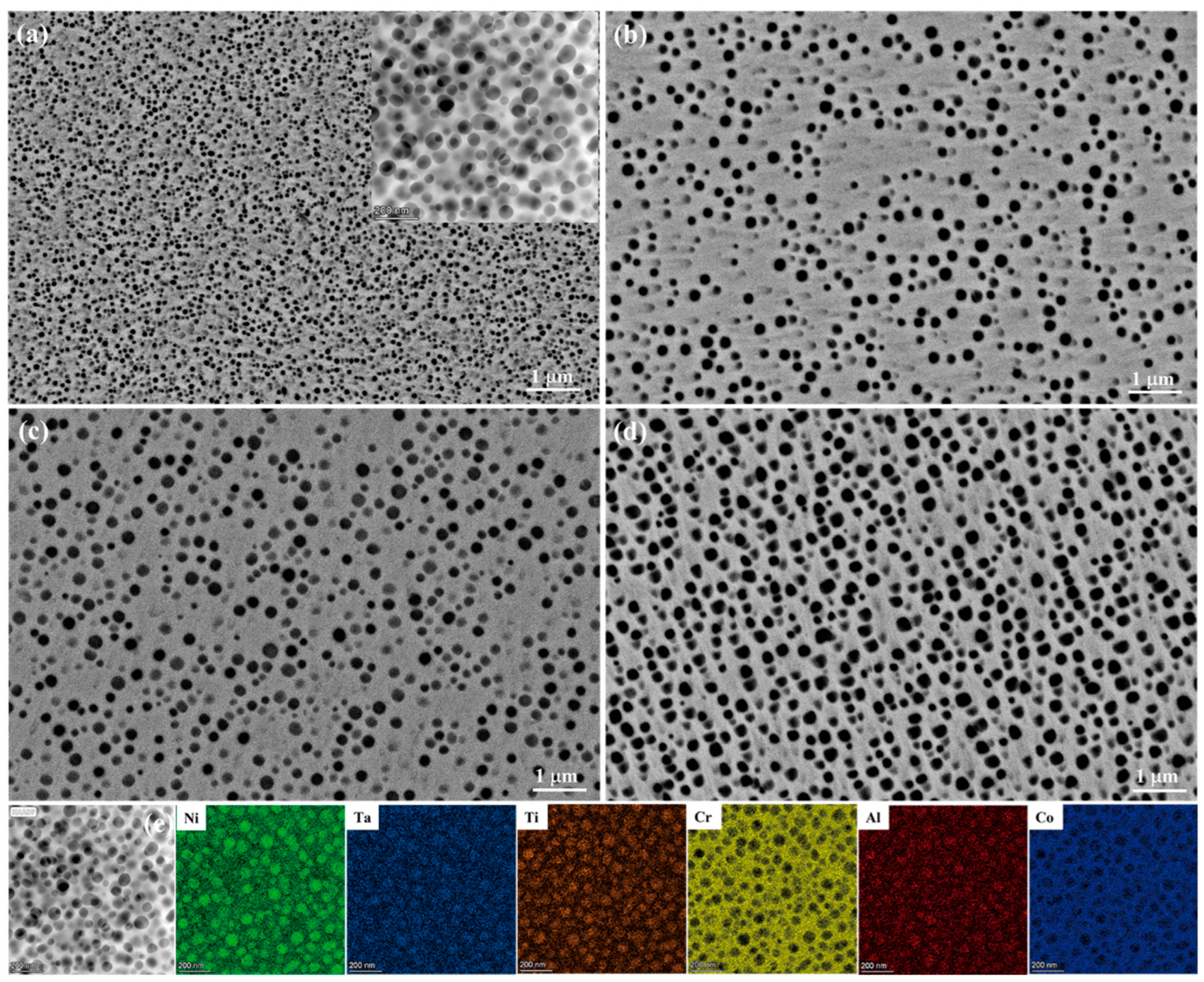

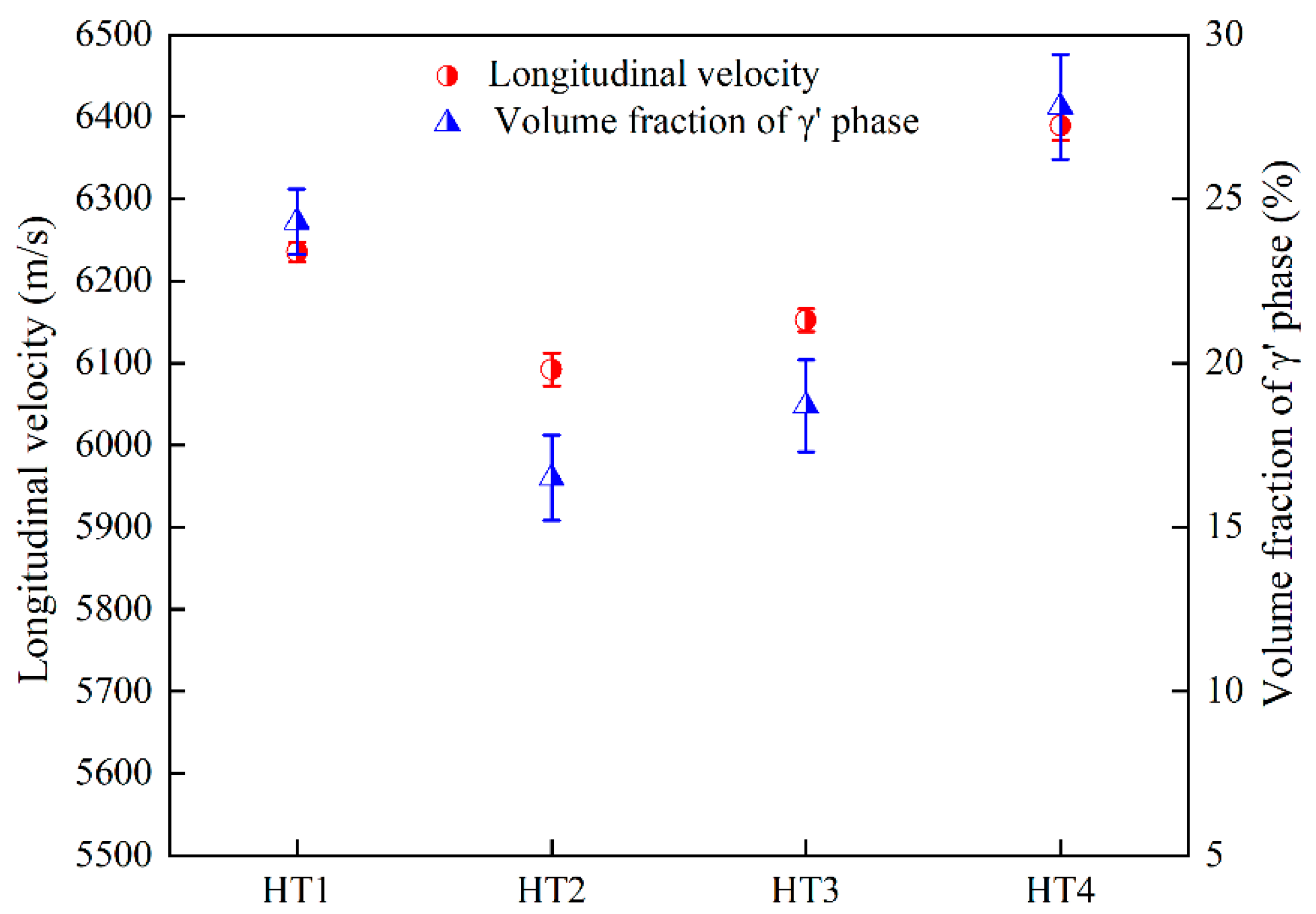
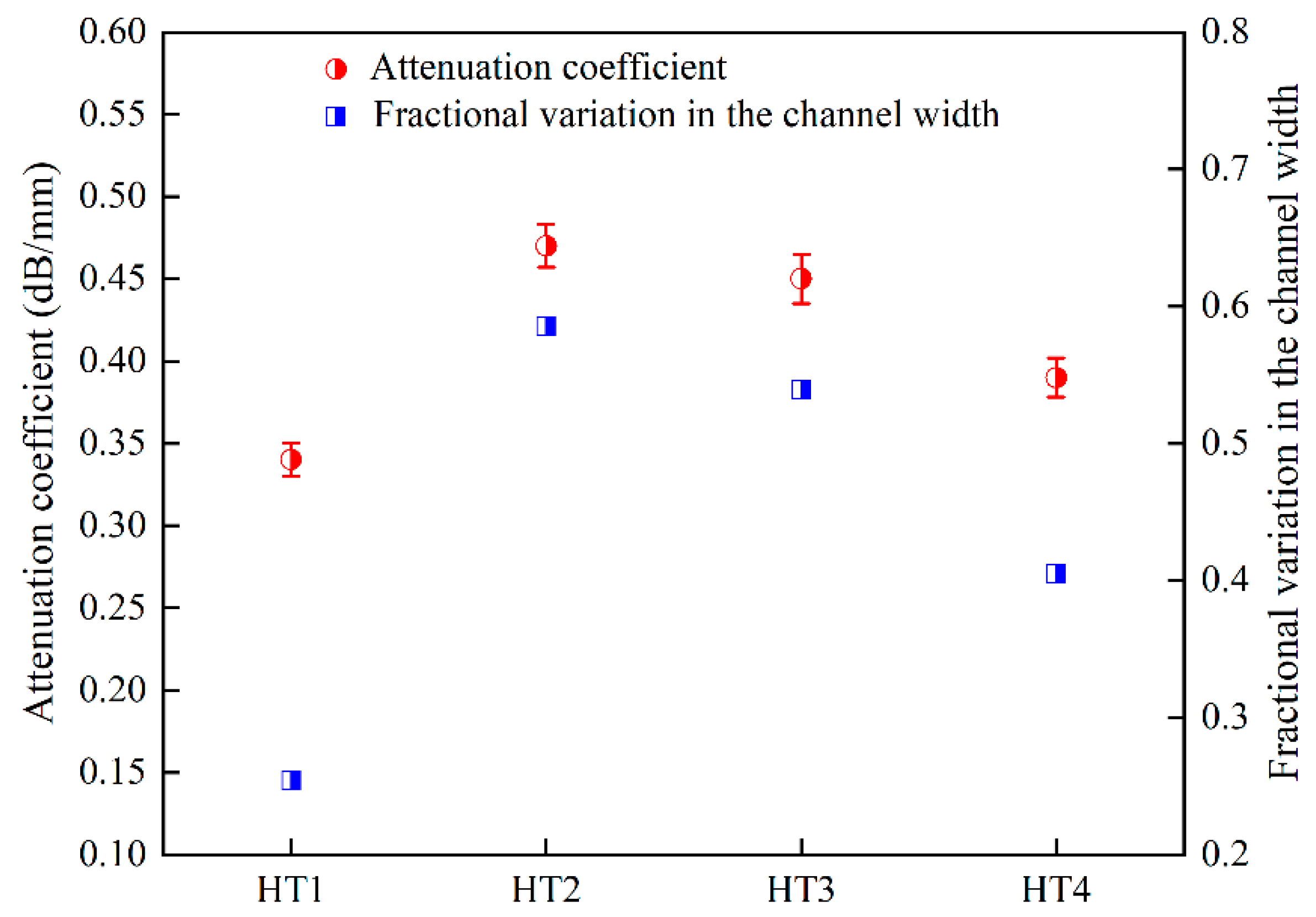
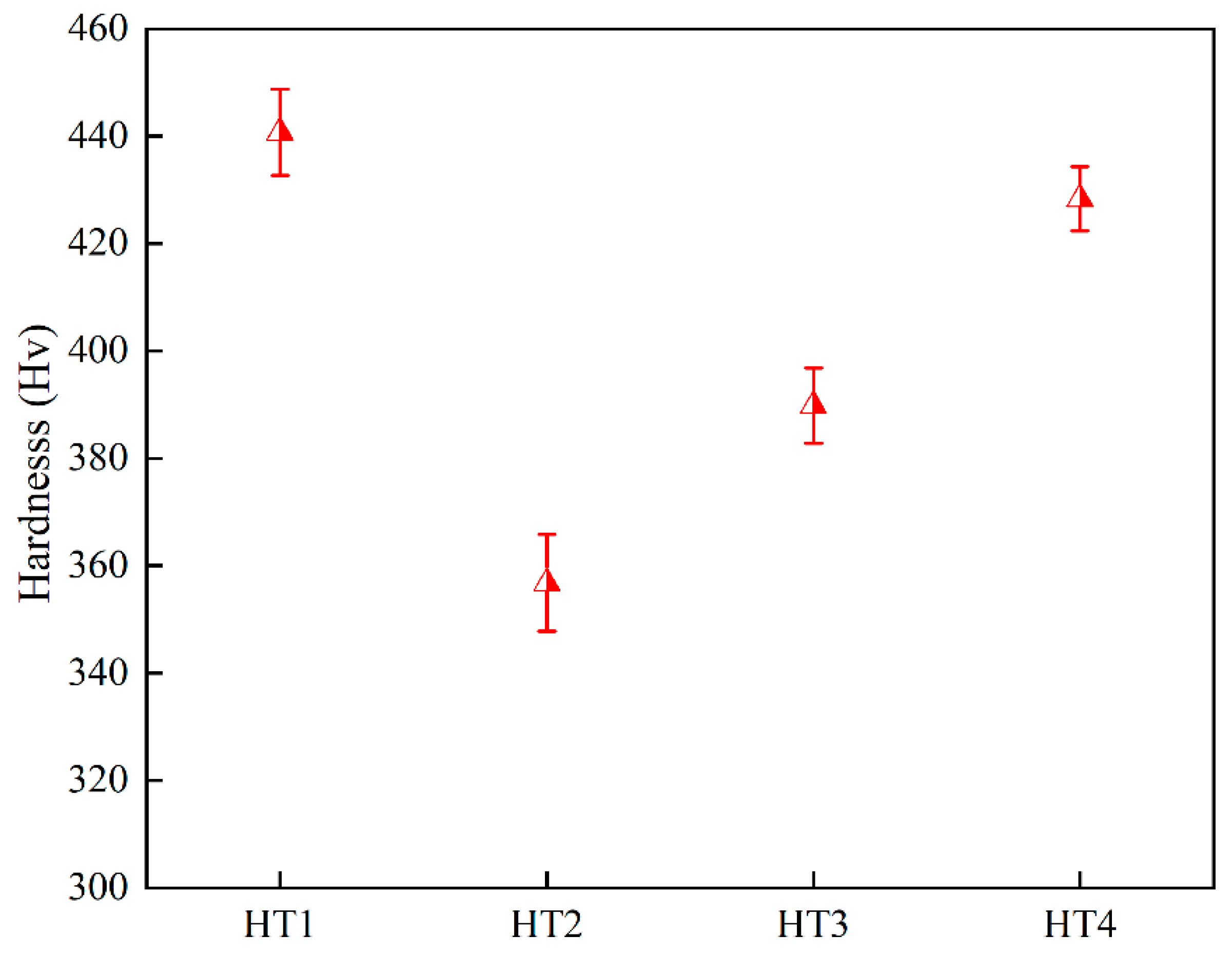

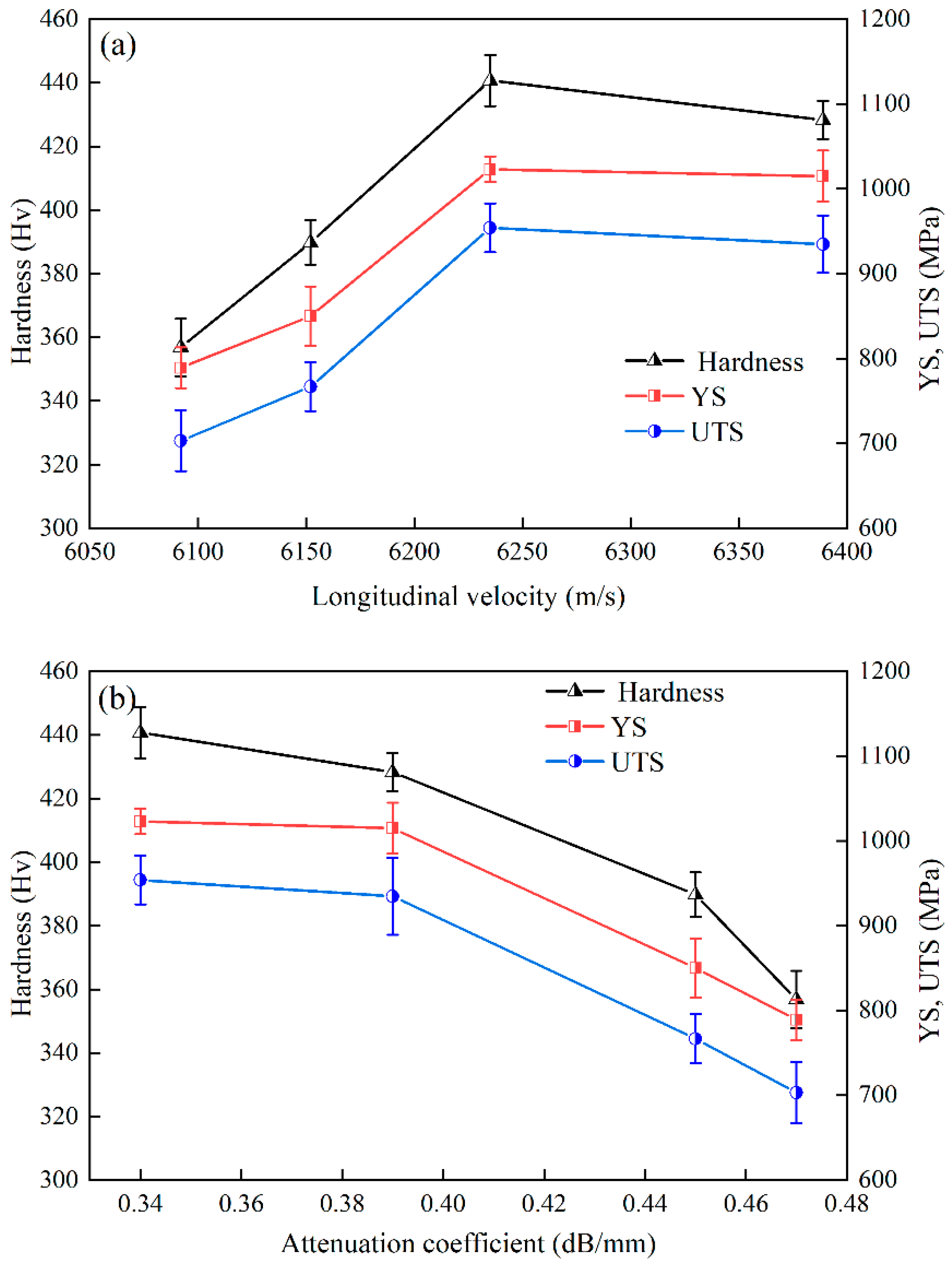
| Sample Code | Heat Treatment Process |
|---|---|
| HT1 | 1160 °C/4 h, FAC 1 + 850 °C/24 h, AC 2 |
| HT2 | 1160 °C/4 h, FAC + 1000 °C/6 h, AC |
| HT3 | 1160 °C/4 h, FAC + 1000 °C/6 h, AC + 800 °C/4 h, AC |
| HT4 | 1160 °C/4 h, FAC + 1000 °C/6 h, FAC + 900 °C/24 h, AC + 700 °C/16 h, AC |
Publisher’s Note: MDPI stays neutral with regard to jurisdictional claims in published maps and institutional affiliations. |
© 2022 by the authors. Licensee MDPI, Basel, Switzerland. This article is an open access article distributed under the terms and conditions of the Creative Commons Attribution (CC BY) license (https://creativecommons.org/licenses/by/4.0/).
Share and Cite
Jie, Z.; Yang, Z.; Xu, T.; Sun, C. Effect of Nano-Sized γ′ Phase on the Ultrasonic and Mechanical Properties of Ni-Based Superalloy. Nanomaterials 2022, 12, 4162. https://doi.org/10.3390/nano12234162
Jie Z, Yang Z, Xu T, Sun C. Effect of Nano-Sized γ′ Phase on the Ultrasonic and Mechanical Properties of Ni-Based Superalloy. Nanomaterials. 2022; 12(23):4162. https://doi.org/10.3390/nano12234162
Chicago/Turabian StyleJie, Ziqi, Zhaoning Yang, Tao Xu, and Chongfeng Sun. 2022. "Effect of Nano-Sized γ′ Phase on the Ultrasonic and Mechanical Properties of Ni-Based Superalloy" Nanomaterials 12, no. 23: 4162. https://doi.org/10.3390/nano12234162




